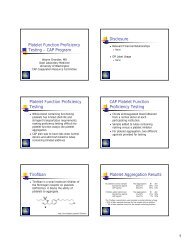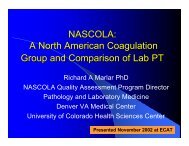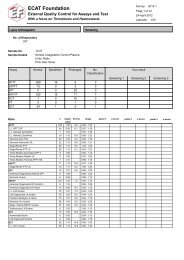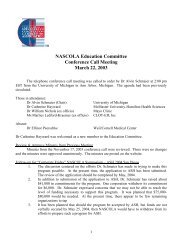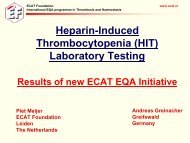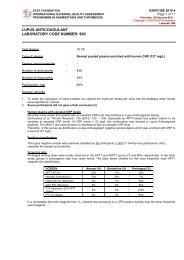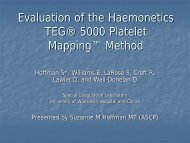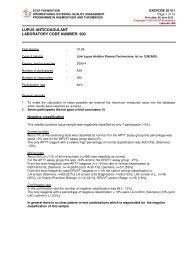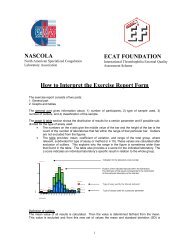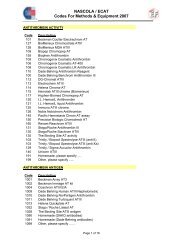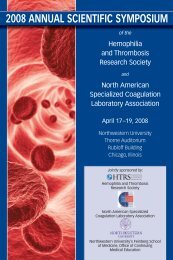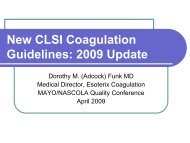1530-1600 MLedfordKraemerADAMTS13 Testing ... - NASCOLA
1530-1600 MLedfordKraemerADAMTS13 Testing ... - NASCOLA
1530-1600 MLedfordKraemerADAMTS13 Testing ... - NASCOLA
You also want an ePaper? Increase the reach of your titles
YUMPU automatically turns print PDFs into web optimized ePapers that Google loves.
ADAMTS-13 Assays<br />
CLOT-ED 2007<br />
Marlies Ledford-Kraemer<br />
MBA, BS, MT(ASCP)SH<br />
Laboratory <strong>Testing</strong> for TTP:<br />
ADAMTS-13 Activity and Antigen Assays<br />
Disclosure<br />
I have no relevant financial<br />
relationship(s) that are in any<br />
way associated with the content<br />
of this presentation<br />
Marlies Ledford-Kraemer,<br />
MBA, BS, MT(ASCP)SH<br />
I will not be discussing “off label<br />
usage” of any pharmacologic<br />
agent/product/device<br />
Revised: mmvii<br />
1<br />
www.CLOT-ED.com 2<br />
Topics for Discussion<br />
Introduction to ADAMTS-13<br />
Introduction to ADAMTS-13<br />
ADAMTS-13 Activity Assays<br />
ADAMTS-13 Inhibitory Assays<br />
ADAMTS-13 Antigen Assays<br />
The 13th member of the ADAMTS<br />
(A Disintegrin<br />
And<br />
Metalloprotease<br />
with<br />
ThromboSpondin<br />
type 1 motifs)<br />
family of metalloproteases<br />
Previously termed VWF cleaving protease<br />
www.CLOT-ED.com 3<br />
www.CLOT-ED.com 4<br />
Signal<br />
Propeptide<br />
ADAMTS-13 Protease<br />
Metalloprotease 1 Cysteine<br />
Disintegrin<br />
Spacer 2 3 4 5 6 7 8<br />
Rich<br />
Thrombospondin Repeats<br />
Cleaves Tyr-Met Bond<br />
Binds VWF A2 Domain<br />
Sadler JE. J Thromb Haemost 2005;3:1702-9.<br />
ADAMTS-13 is specific for von Willebrand Factor (VWF) and<br />
appears to be resistant to “all” plasma protease inhibitors<br />
ADAMTS-13 gene is mapped to chromosome 9q34<br />
– Gene spans 37kb and contains 29 exons<br />
Precursor polypeptide composed of 1427 amino acid residues<br />
Synthesized in liver and endothelial cells as a zymogen and<br />
becomes activated upon propeptide cleavage<br />
Highly glycosylated (apparent mass of 180 kDa)<br />
Plasma concentration is ~ 1 μg/mL<br />
Plasma half-life is ~ 2-3 days<br />
Protease activity is dependent on both Zn +2 & Ca +2 ions<br />
www.CLOT-ED.com 5<br />
CUB<br />
CUB<br />
ADAMTS-13 Function<br />
Cleaves its substrate, von Willebrand Factor (VWF), in the A2<br />
domain at Tyr 1605 —Met 1606<br />
Responsible for normal proteolysis of VWF multimers<br />
– On VWF multimer gels, seen as satellite bands (consisting of<br />
dimers either with or without N-terminal fragment attached)<br />
– On denatured gels, seen as 176 kDa & 140 kDa fragments<br />
resulting from digestion of 225 kDa protomer<br />
VWF substrate, in vivo, regulates its own cleavage<br />
– Shear stress makes VWF A2 domain accessible to protease<br />
Denaturing agents or low salt concentrations unfold<br />
normal VWF in vitro<br />
Mutations within VWF A2 domain (VWD Type 2A),<br />
impair folding of VWF thereby exposing Tyr-Met bond<br />
resulting in exaggerated proteolysis<br />
www.CLOT-ED.com 6<br />
Mayo/<strong>NASCOLA</strong> Coagulation <strong>Testing</strong> Quality<br />
April 26, 2007<br />
1
ADAMTS-13 Assays<br />
CLOT-ED 2007<br />
Marlies Ledford-Kraemer<br />
MBA, BS, MT(ASCP)SH<br />
C-C<br />
C-C<br />
C-C<br />
C-C<br />
C-C<br />
C-C<br />
Thrombotic Thrombocytopenic Purpura<br />
N<br />
N N<br />
Dimer<br />
Dimer<br />
Multimer<br />
N N<br />
VWF Proteoltyic Fragments<br />
C-C<br />
N N N<br />
N N<br />
ADAMTS-13<br />
Slower Triplet<br />
2050 + 2050 + 842 = 4942 aa<br />
MW=545 kDa<br />
N N<br />
N N<br />
Multimers n = Very Large Multimers<br />
C-C<br />
A<br />
n<br />
C-C<br />
Intermediate Triplet<br />
d<br />
/<br />
2050 + 2050 = 4100 aa and/or<br />
O<br />
1208 + 2050 + 842 = 4100 aa<br />
N<br />
N r<br />
N N<br />
MW=450 kDa<br />
C-C<br />
aa = amino acids<br />
Faster Triplet<br />
Adapted from: Fischer BE, et al.<br />
Biochem J. 1998;331 (Pt 2):483-8.<br />
1208 + 2050 = 3258 aa<br />
MW=360 kDa<br />
N<br />
www.CLOT-ED.com 7<br />
N<br />
TTP is a life-threatening disseminated thrombotic microangiopathy of<br />
which the pathologic hallmark is platelet-rich microthrombi in the<br />
small vessels of multiple organs<br />
In the high shear stress<br />
environment of the microcirculation,<br />
presence of UL MWM (due to<br />
decrease in ADAMTS-13) leads to<br />
UL MWM<br />
platelet clumping<br />
Neurologic Symptoms<br />
Hemolytic Anemia<br />
TTP<br />
Normal<br />
Fever<br />
Thrombocytopenia<br />
TTP = Thrombotic Thrombocytopenic Purpura;<br />
UL MWM = Unusually Large Moleculer Weight (VWF) Multimers<br />
Renal Dysfunction<br />
Thrombocytopenia, and ischemic<br />
neurological, renal & other organ<br />
dysfunction as well as red blood<br />
cell fragmentation in partially<br />
occluded arterioles and capillaries<br />
www.CLOT-ED.com 8<br />
ADAMTS-13 and TTP<br />
Congenital TTP (Upshaw-Schülman Syndrome)<br />
– Caused by homozygous or compound heterozygous<br />
mutations in the ADAMTS-13 gene<br />
– ADAMTS-13 is non-functional (activity
ADAMTS-13 Assays<br />
CLOT-ED 2007<br />
Marlies Ledford-Kraemer<br />
MBA, BS, MT(ASCP)SH<br />
Techniques….Continued<br />
FRET (fluorescence [Förster] resonance energy transfer)<br />
– An energy transfer mechanism between two fluorescent molecules: a<br />
fluorescent donor (emitter) and a fluorescent acceptor (absorbs or<br />
quenches the signal)<br />
– If ADAMTS-13 cleaves the Tyr-Met bond, then the excited donor<br />
energy, which is transferred when the substrate is intact and<br />
quenched by the acceptor, is no longer quenched thereby allowing<br />
fluorescent emission by the donor molecule (Kokame, 2005)<br />
Flow chamber (high shear, non-static environments)<br />
– Parallel plate perfusion system using human umbilical vein endothelial<br />
cells (HUVEC)<br />
• HUVEC release UL VWF multimers that form very long platelet decorated<br />
string-like structures; in the presence of ADAMTS-13 these structures<br />
disappear rapidly (Dong, 2002)<br />
– Cone and Plate(let) Analyzer (Shenkman, 2006)<br />
• Shear stress unfolds VWF allowing for subsequent platelet-platelet<br />
interactions and deposition onto a polystyrene surface<br />
www.CLOT-ED.com 13<br />
Substrates<br />
VWF<br />
– Purified, full length VWF (Furlan, 1997), (Tsai, 1998), and<br />
(Gerritsen, 1999)<br />
– Recombinant VWF [rVWF] (Obert, 1999) & (Shenkman, 2006),<br />
VWF from high purity VWF concentrate (Böhm, 2002)<br />
Fusion Proteins (peptidyl substrates fused with various detectors)<br />
– rVWF-A2 domain with N-terminal 6xHis-tag (Cruz, 2003)<br />
– rVWF-A2 domain tagged with N-terminal 6xHis and C-terminal<br />
Tag-100 (Whitelock, 2004)<br />
– Recombinant 73 amino acid fragment of VWF-A2 domain<br />
[rVWF73] tagged with N-terminal GST and C-terminal 6xHis<br />
(Zhou, 2004), (Kokame, 2004)<br />
– Fluorogenic peptide, FRETS-VWF73, in which Q1599 is replaced<br />
with emitter A2pr Nma and N1610 is replaced with quencher<br />
A2pr Dnp (Kokame, 2005)<br />
www.CLOT-ED.com 14<br />
VWF Monomer<br />
(2050 amino acids)<br />
C<br />
A1<br />
C<br />
Miniaturizing the Substrate<br />
140 kDa (N-Terminus) 176 kDa (C-Terminus)<br />
Y1605-M1606<br />
S D1 D2 D3 A1 A2 A3 D4 B1-B3 C1 C2 CK<br />
A2<br />
Y1605<br />
M1606<br />
A3<br />
1260 - 1479 1480<br />
1672 1673-1874<br />
rVWF73<br />
D1596 - R1668<br />
www.CLOT-ED.com 15<br />
RGDS<br />
C<br />
C<br />
Why Miniaturization?<br />
Disadvantages of full-length VWF as substrate<br />
– Requires denaturing agents to unfold VWF in order to<br />
expose cleavage sites in VWF-A2 domains<br />
– Long incubation times required for protease to act<br />
upon the substrate<br />
– Full-length VWF derived from plasma contains<br />
ADAMTS-13, which requires removal prior to use<br />
Advantages of monomeric fragments<br />
– Contain only one cleavage site<br />
– No denaturing reagents required since the fragment is not bulky and<br />
hence cleavage site is not hidden<br />
– Greater susceptibility to proteolysis therefore no need for divalent<br />
cations, in the assay, to activate ADAMTS-13<br />
– Provide opportunity to incorporate specific detector tags to enhace<br />
visualization/quantification<br />
www.CLOT-ED.com 16<br />
Direct Assays<br />
Demonstrate or measure appearance of cleavage products<br />
resulting from ADAMTS-13 activity on “VWF” substrate<br />
Detection of dimeric 176 & 140 kDa fragments on denatured<br />
SDS-PAGE gels (Tsai, 1998)<br />
Quantify colorimetric changes due to appearance of cleavage<br />
products (Wu, 2006)<br />
Quantify fluorometric changes attributable to appearance of<br />
cleavage products (Kokame, 2005)<br />
Indirect Assays<br />
Measure residual “VWF” substrate or its disappearance<br />
Measure change in VWF multimer size (Furlan, 1997)<br />
– On multimer analysis, disappearance of high molecular weight VWF<br />
multimers after digestion with ADAMTS-13<br />
Low molecular weight VWF multimer forms resulting from<br />
digestion show reduced collagen binding activity (Gerritsen, 1999)<br />
or ristocetin cofactor activity (Böhm, 2002)<br />
Residual “VWF” substrate quantified by the binding of tagged<br />
monoclonal antibodies to the substrate (Whitelock, 2004 & Zhou,<br />
2004); there is an inverse relationship between ADAMTS-13<br />
activity and colorimetric changes<br />
Platelet VWF string formation (Dong, 2002) or platelet deposition<br />
onto a plate (Shenkman, 2006) is inversely related to ADAMTS-13<br />
activity<br />
www.CLOT-ED.com 17<br />
www.CLOT-ED.com 18<br />
Mayo/<strong>NASCOLA</strong> Coagulation <strong>Testing</strong> Quality<br />
April 26, 2007<br />
3
ADAMTS-13 Assays<br />
CLOT-ED 2007<br />
Marlies Ledford-Kraemer<br />
MBA, BS, MT(ASCP)SH<br />
Multicenter Studies<br />
Study in 2002 (Studt, et al) compared 4 assays available in 5<br />
research centers<br />
– 30 samples distributed with 14 having activity levels of
ADAMTS-13 Assays<br />
CLOT-ED 2007<br />
Marlies Ledford-Kraemer<br />
MBA, BS, MT(ASCP)SH<br />
Assay Types<br />
Both direct and indirect activity assays can be modified<br />
to detect inhibitors of ADAMTS-13 activity<br />
– Mixing study is used to determine effect that antibody in<br />
patient plasma has on ADAMTS-13 and VWF substrate<br />
supplied by normal pooled plasma (NPP)<br />
• If inhibitory activity is present in patient plasma, then residual<br />
ADAMTS-13 in NPP is low and can not digest VWF<br />
– Expected VWF cleavage products are not produced and high<br />
molecular weight VWF multimers (active forms) are retained<br />
• If no antibody is present, then residual ADAMTS-13 activity in NPP<br />
is high and digests the VWF substrate<br />
– Expected loss of high molecular weight multimers occurs with<br />
concomitant loss of VWF activity<br />
ELISA assays to directly quantify the inhibitor<br />
www.CLOT-ED.com 25<br />
Mixing Study Method<br />
Patient plasma heated at 56 o C for 30-60 minutes to<br />
eliminate endogenous ADAMTS-13 activity<br />
– NPP treated in same manner to serve as control<br />
Serial dilutions of treated plasma can be made in TBS or<br />
PBS buffers, with or without bovine serum albumin<br />
Heat treated plasma (either neat or serial dilutions as<br />
noted above) mixed 1:1 with NPP<br />
1:1 mixture(s) incubated at 37 o C for 30-120 minutes<br />
– Time for antibody to act against ADAMTS-13<br />
Measure residual ADAMTS-13 activity by any direct or<br />
indirect assay<br />
– Direct assays show less end-product<br />
– Indirect assays detect more residual substrate<br />
www.CLOT-ED.com 26<br />
Mixing Study Interpretation<br />
Qualitative<br />
– General (definite inhibitor, uncertain/low titer inhibitor, or no inhibitor)<br />
– Percent inhibition<br />
• Patient sample considered positive for ADAMTS-13 inhibitor if >30% of<br />
proteolytic cleavage of NPP substrate is blocked<br />
• Cut-off percentages should be set by individual laboratories<br />
Semi-quantitative<br />
– Residual ADAMTS-13<br />
activity seen in 1:1 patient<br />
plasma/NPP mixtures is<br />
reported in Bethesda units<br />
• Calibration curve: Mix NPP<br />
with 1:1 heat-inactivated<br />
NPP (ADAMTS-13<br />
inactivated) or buffer and<br />
incubate at 37 o C for 30-<br />
120 minutes<br />
• Dilute mixture serially with<br />
buffer<br />
ADAMTS-13 Activity/Inhibitor Calibration Curve<br />
Dilution 1:20 1:40 1:80 Buffer<br />
Direct Assays<br />
ADAMTS-13 Activity<br />
( % VWF Inhibited)<br />
Multimer Pattern<br />
100% 50% 25% 0%<br />
Indirect Assays<br />
Residual VWF<br />
(% Inhibitor Present)<br />
None 50% 75% 100%<br />
Multimer patterns extracted from: Furlan M, et al. NEJM 1998;339:1578-34.<br />
www.CLOT-ED.com 27<br />
Commercial Availability<br />
IgG autoantibodies to ADAMTS-13 can be measured directly using<br />
ELISA assays<br />
– ELISA plate coated with recombinant human full-length ADAMTS-13<br />
– Anti-ADAMTS-13 IgG autoantibodies in diluted patient plasma bind to<br />
capture antigen<br />
– Colorimetric detection is by the action of a secondary conjugated anthuman<br />
IgG labeled with horseradish peroxidase upon the substrate<br />
TMB (perborate-3,3’-5,5’-tetramethylbenzidine)<br />
– A reference curve is based on five dilutions of a plasma with known<br />
concentration of anti-ADAMTS-13 IgG<br />
– Inhibitor levels are reported in anti-ADAMTS-13 units/mL<br />
American Diagnostica: IMUBIND ® ADAMTS13 Autoantibody (RUO)<br />
Technoclone: TECHNOZYME ADAMTS-13 INH (RUO)<br />
– Distributed in the US through diaPharma<br />
www.CLOT-ED.com 28<br />
Quality Concerns<br />
ELISA inhibitor assays<br />
– Do not distinguish between inhibitory and non-inhibitory IgG<br />
antibodies<br />
• May lead to over-estimation of anti-ADAMTS-13 antibodies<br />
– High titers of non-ADAMTS-13 autoantibodies may cause false<br />
positives<br />
Activity-based inhibitor assays<br />
– Autoantibodies must be inhibitory in order to be detected and titrated<br />
by classical mixing studies<br />
• Non-neutralizing antibodies will not be detected<br />
– Lower detection limits of various ADAMTS-13 activity assays must be<br />
considered as these will impact modified inhibitor assays<br />
– Shelat, et al noted that a modified activity assay based on FRETS-<br />
VWF73 is sensitive and specific for detecting inhibitory autoantibodies<br />
to ADAMTS-13<br />
Both activity-based and ELISA assays detect only free IgG<br />
inhibitors and not those already bound to ADAMTS-13<br />
(antigen/antibody complex)<br />
www.CLOT-ED.com 29<br />
ADAMTS-13<br />
Antigen Assays<br />
www.CLOT-ED.com 30<br />
Mayo/<strong>NASCOLA</strong> Coagulation <strong>Testing</strong> Quality<br />
April 26, 2007<br />
5
ADAMTS-13 Assays<br />
CLOT-ED 2007<br />
Marlies Ledford-Kraemer<br />
MBA, BS, MT(ASCP)SH<br />
Overview of Assays<br />
Quantify level of ADAMTS-13 antigen present in plasma<br />
For assays using polyclonal antibodies, both free<br />
ADAMTS-13 and that complexed to antibody (bound) are<br />
detected in acquired TTP<br />
– Two kits available commercially<br />
– Rieger, et al developed a polyclonal antibody-based<br />
antigen assay and attempted to use ADAMTS-13 activity<br />
to antigen ratios to differentiate between various<br />
conditions<br />
Feys, et al developed a monoclonal antibody-based<br />
ELISA<br />
– Autoantibodies did not appear to interfere with the assay<br />
American Diagnostica<br />
IMUBIND ® ADAMTS13 ELISA (RUO)<br />
Standard for curve is a dilute normal human plasma<br />
calibrated against a recombinant ADAMTS-13<br />
– Interpolated patient values are reported in ng/mL<br />
Quality concerns<br />
– Platelet<br />
contamination<br />
interferes with<br />
assay<br />
– Only 2 freezethaw<br />
cycles can<br />
be tolerated<br />
450nm<br />
Y<br />
ADAMTS13<br />
Anti-ADAMTS<br />
ADAMTS-13<br />
Assay Design<br />
TMB substrate<br />
Strepavidin-horseradish<br />
peroxidase (SA-HRP) conjugate<br />
Biotinylated rabbit anti-human<br />
polyclonal anti-ADAMTS-13<br />
detection antibody<br />
Patient plasma containing<br />
ADAMTS-13<br />
Rabbit polyclonal anti-human<br />
ADAMTS-13 immobilized to<br />
microtiter plate<br />
www.CLOT-ED.com 31<br />
www.CLOT-ED.com 32<br />
Technoclone (diaPharma)<br />
TECHNOZYM ® ADAMTS-13 (RUO)<br />
– Test system determines both ADAMTS-13 activity and<br />
antigen in the same microtiter plate well<br />
– After removal (washing step) of substrate used to assess<br />
ADAMTS-13 activity, ADAMTS-13 antigen is assayed by<br />
standard ELISA technology<br />
• Use a polyclonal anti-human ADAMTS-13 antibody conjugated with<br />
horseradish peroxidase (HRP)<br />
• HRP acts on a substrate tagged with a fluorophore<br />
• Fluorescence emission is read at 360/460nm<br />
ADAMTS-13<br />
Assays<br />
Activity<br />
(FRETS-VWF73)<br />
Neutralizing<br />
Activity<br />
(Modified FRETS-<br />
VWF73 for Inhibitor)<br />
Anti-ADAMTS-13<br />
IgG (ELISA)<br />
ADAMTS-13<br />
Antigen (ELISA)<br />
Healthy Donors<br />
(Reference)<br />
So What’s the Point?<br />
Differentiate between hereditary and<br />
acquired TTP<br />
Discriminate between inhibitory and noninhibitory<br />
autoantibodies<br />
Aid in determining appropriate therapies<br />
Normal (> 50%) < 5 - 10% < 10% 10% - 50% 10 % - 50%<br />
Negative<br />
(Test plasma blocks<br />
< 30% of proteolytic Negative Positive Negative Negative<br />
cleavage of<br />
substrates by NPP)<br />
Negative<br />
(< 12 U/mL)<br />
Normal<br />
(350 -730 ng/mL)<br />
Negative Positive Positive Negative<br />
Low to<br />
Undectable<br />
Adapted/Modified from Shelat, et al. J Thromb Haemost 2006;4:1707-17.<br />
Acquired TTP (Idiopathic or Non-idiopathic)<br />
Hereditary<br />
Non-inhibitory AB No AB<br />
TTP Inhibitory AB<br />
(In Idiopathic or (In Idiopathic or<br />
(Only in Idiopathic TTP)<br />
Non-idiopathic TTP) Non-idiopathic TTP)<br />
Moderately<br />
Decreased<br />
Normal<br />
Legend: AB = ADAMTS-13 Autoantibody; NPP = Normal Pooled Plasma<br />
Borderline Normal<br />
www.CLOT-ED.com 33<br />
www.CLOT-ED.com 34<br />
What Can Any of Us Do??<br />
Reviews and articles of interest:<br />
References<br />
And pick a good reference laboratory!!!<br />
And ask them which assays they perform<br />
…………. because you now know what<br />
they are all about!!!!!<br />
www.CLOT-ED.com 35<br />
Feys HB, et al. ADAMTS-13 plasma level determination uncovers antigen absence in acquired thrombotic thrombocytopenic<br />
purpura and ethnic differences. J Thromb Haemost. 2006;4(5):955-62.<br />
Fischer BE, Thomas KB, Schlokat U, Dorner F. Triplet structure of human von Willebrand factor. Biochem J. 1998;331 (Pt<br />
2):483-8.<br />
Galbusera M, Noris M, Remuzzi G. Thrombotic thrombocytopenic purpura--then and now. Semin Thromb Hemost.<br />
2006;32(2):81-9.<br />
Lammle B, Kremer Hovinga JA, Alberio L. Thrombotic thrombocytopenic purpura. J Thromb Haemost. 2005;3(8):1663-75.<br />
Rieger M, et al. Relation between ADAMTS13 activity and ADAMTS13 antigen levels in healthy donors and patients with<br />
thrombotic microangiopathies (TMA). Thromb Haemost. 2006;95(2):212-20.<br />
Sadler JE. von Willebrand factor: two sides of a coin. J Thromb Haemost. 2005;3(8):1702-9.<br />
Shelat SG, Ai J, Zheng XL. Molecular biology of ADAMTS-13 and diagnostic utility of ADAMTS13 proteolytic activity and<br />
inhibitor assays. Semin Thromb Hemost. 2005;31(6):659-72.<br />
Shelat SG, Smith P, Ai J, Zheng XL. Inhibitory autoantibodies against ADAMTS-13 in patients with thrombotic<br />
thrombocytopenic purpura bind ADAMTS-13 protease and may accelerate its clearance in vivo. J Thromb Haemost.<br />
2006;4(8):1707-17.<br />
Studt JD,et al. Fatal congenital thrombotic thrombocytopenic purpura with apparent ADAMTS13 inhibitor: in vitro inhibition<br />
of ADAMTS13 activity by hemoglobin. Blood. 2005;105(2):542-4.<br />
Studt JD, et al. Measurement of von Willebrand factor-cleaving protease (ADAMTS-13) activity in plasma: a multicenter<br />
comparison of different assay methods. J Thromb Haemost. 2003;1(9):1882-7.<br />
Tripodi A, et al. Measurement of von Willebrand factor cleaving protease (ADAMTS-13): results of an international<br />
collaborative study involving 11 methods testing the same set of coded plasmas. J Thromb Haemost. 2004;2(9):1601-9.<br />
Tsai HM, et al. ADAMTS13-binding IgG are present in patients with thrombotic thrombocytopenic purpura. Thromb<br />
Haemost. 2006;95(5):886-92.<br />
Veyradier A, Girma JP. Assays of ADAMTS-13 activity. Semin Hematol. 2004;41(1):41-7.<br />
Veyradier A, Meyer D. Thrombotic thrombocytopenic purpura and its diagnosis. J Thromb Haemost. 2005;3(11):2420-7.<br />
References for specific assays are included in the presentation and Reprint<br />
www.CLOT-ED.com 36<br />
Mayo/<strong>NASCOLA</strong> Coagulation <strong>Testing</strong> Quality<br />
April 26, 2007<br />
6



